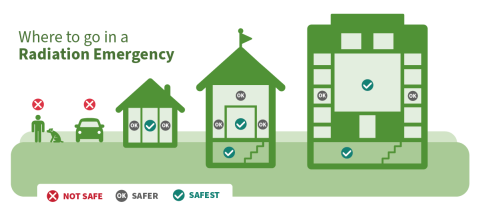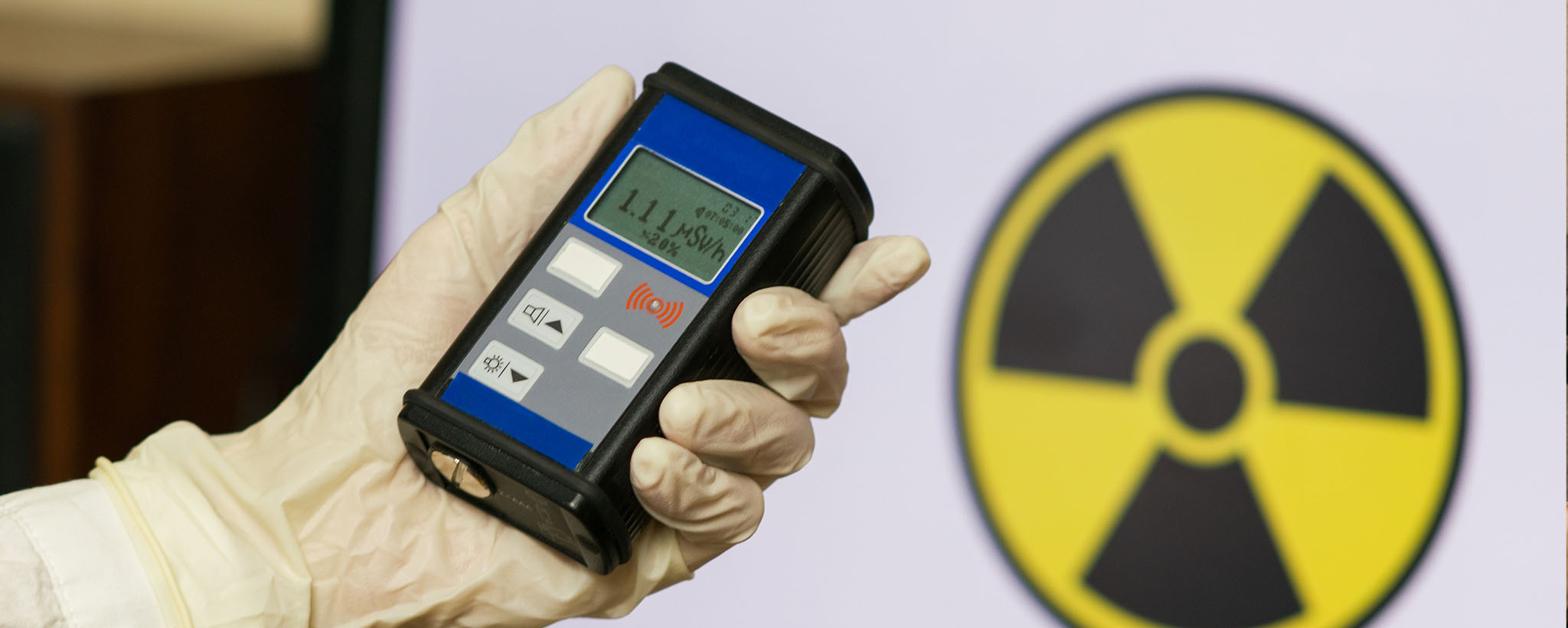Prepare Now
Stay Safe During
Be Safe After
Associated Content
There are different types of radiation emergencies that vary in how much damage they cause and harm they pose to the public. Some examples of radiation emergencies include: a nuclear detonation (explosion), an accident at a nuclear power plant, a transportation accident involving a shipment of radioactive materials, or an occupational exposure like in a healthcare or research setting. While the extent of the damage will vary, the steps to protect yourself from radiation are the same. You can keep your family safe by knowing what to do and being prepared if an incident occurs. Follow these simple steps:
The best way to stay safe in any radiation emergency is to get inside, stay inside and stay tuned. Putting material between you and the radiation provides protection while you tune in for instructions from responders.

HOW TO STAY SAFE IN THE EVENT OF A RADIATION EMERGENCY
Prepare NOW
Like in any emergency, you need reliable information, enough supplies and a plan to protect yourself and your family during radiation and nuclear emergencies.
- Have several ways to receive emergency alerts. Download the FEMA App and receive real-time alerts from the National Weather Service for up to five locations nationwide. Sign up for community alerts in your area from your local emergency management agency to receive timely and specific information for your area. Have a battery-powered or hand crank radio, which will continue to work if other forms of communication fail.
- Build an Emergency Supply Kit. Include a spare change of clothes for each family member, a trash bag for contaminated clothing, and sealed food, water and medicine.
- Make a Family Emergency Communications Plan. Decide where your family will meet if you cannot meet at home. Identify an out-of-state contact who you can inform of your whereabouts and safety. Make plans with friends or family to identify safe places to stay if you need to evacuate. Familiarize yourself with school, work and care-facility plans for staying inside/sheltering-in-place and evacuation.
Stay Safe DURING
During any radiation emergency, follow the radiation protection principles of time, distance, and shielding. Limit your time exposed to radiation, stay as far away as possible from a radioactive source, and shield yourself from radiation by going deep inside a sturdy building.
If the emergency is outside, Get inside. Stay inside. Stay tuned.
GET INSIDE: If warned of the possibility of a radiation hazard, immediately get inside the nearest building and move away from windows. Put as many walls between you and the outside to protect you from the radiation outside.

NUCLEAR DETONATIONS: Nuclear detonations are the most dangerous radiation emergency. It creates a large, deadly blast. If it detonates on the ground, the explosion can suck material up into the air and create dangerous, sand-like, radioactive particles called fallout.
For a nuclear explosion, if you have warning, take cover from the blast behind anything that might offer protection. If you are outside, lie face down to protect exposed skin from the heat and flying debris. After the shockwave passes, go inside the nearest building as quickly as possible.
GET INSIDE: After a detonation, you will have 10 minutes or more to find an adequate shelter before fallout arrives. If a multi-story building or a basement can be safely reached within a few minutes of the explosion, go there immediately. The safest buildings have brick or concrete walls. Underground parking garages and subways can also provide good shelter.
Remain in the most protective location (basement or center of a large building) for the first 24 hours unless threatened by an immediate hazard (e.g., fire, gas leak, building collapse, or serious injury) or informed by authorities that it is safe to leave. Radiation levels decrease rapidly, becoming significantly less dangerous, during the first 24 hours.
STAY INSIDE: Take shelter unless told otherwise. If possible, turn off fans, air conditioners, and forced-air heating units that bring air in from the outside. Close windows and doors. Close fireplace dampers. If you are instructed to stay inside during a radiation emergency, pets and service animals should be inside too. Sheltering usually lasts at least 24 hours.
STAY TUNED: Follow instructions from emergency response officials. If advised to evacuate, listen for information about routes, shelters, and procedures. If you have evacuated, do not return until you are told it is safe to do so by local authorities.
Be Safe AFTER
If you were outside during a radiological release or if you think you have radioactive material on your body, there are simple steps to remove it.

- Remove your outer layer of contaminated clothing to remove radioactive material from your body. Removing your outer layer of clothing can remove up to 90% of radioactive material. Be very careful in removing your clothing to prevent radioactive dust from shaking loose. Avoid touching your eyes, nose, and mouth, if possible.
- Get clean. If possible, take a shower or wash with soap and water to remove any radioactive particles from skin or hair that was not covered. If you cannot wash, use a wipe or clean wet cloth to wipe any skin or hair that was not covered. Do not use household cleaning wipes on your skin. Hand sanitizer does not protect against radioactive material. Follow CDC guidance on Decontamination for Yourself and Others.
- Clean any pets that were outside after the radioactive dust arrived. Gently brush your pet’s coat to remove any radioactive particles and wash your pet with soap and water, if available.
- Stay hydrated and fed: It is safe to eat and drink food that was inside a building. It is safe to eat food in sealed containers that were outside as long as you wipe off the container with a damp towel or cloth before using. Seal these towels or cleaning cloths in a plastic bag and place them away from people and pets. Unsealed foods from outside may be contaminated with radioactive material. Do not consume food from your garden, or food or liquids that were outdoors and uncovered, until authorities tell you it is safe.
- Take care of yourself and others: If you are sick or injured, listen for instructions on how and where to get medical attention. If you are at a public shelter, immediately notify the staff at that facility so they can call a local hospital or clinic. If you are experiencing a medical emergency, call 9-1-1.
- The threat of a radiation or nuclear emergency can be stressful and surviving one can be a traumatic experience. Take care of yourself and talk to someone if you are feeling upset. Follow CDC guidance for managing stress during a traumatic event.
Associated Content
- Nuclear Detonation Safety: Food, Drinking Water and Medicine (PDF)
- PrepTalks: Brooke Buddemeier "Saving Lives After a Nuclear Detonation." | FEMA.gov
- Centers for Disease Control (CDC): Radiation Emergencies
- U.S. Environmental Protection Agency (EPA): Protecting Yourself from Radiation


